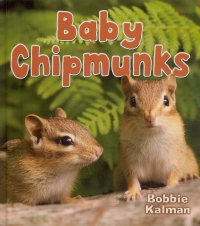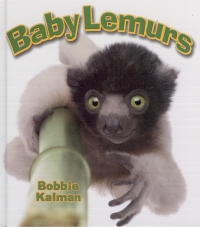| ________________
CM . . . . Volume XVII Number 12. . . .November 19, 2010. 
 |
Baby Chipmunks. (It's Fun to Learn About Baby Animals).
Bobbie Kalman.
St. Catharines, ON: Crabtree, 2011.
24 pp., pbk. & hc., $7.95 (pbk.), $18.36 (RLB.).
ISBN 978-0-7787-4897-7 (pbk.), ISBN 978-0-7787-4892-2 (RLB.).
Subject Heading:
Chipmunks-Infancy-Juvenile literature.
Preschool-grade 3 / Ages 4-8.
Review by Suzanne Pierson.
****/4
|
| |
 |
Baby Lemurs. (It's Fun to Learn About Baby Animals).
Bobbie Kalman.
St. Catharines, ON: Crabtree, 2011.
24 pp., pbk. & hc., $7.95 (pbk.), $18.36 (RLB.).
ISBN 978-0-7787-4898-4 (pbk.), ISBN 978-0-7787-4893-9 (RLB.).
Subject Heading:
Lemurs-Infancy-Juvenile literature.
Preschool-grade 3 / Ages 4-8.
Review by Suzanne Pierson.
****/4
|
| |
 |
Baby Polar Bears. (It's Fun to Learn About Baby Animals).
Bobbie Kalman.
St. Catharines, ON: Crabtree, 2011.
24 pp., pbk. & hc., $7.95 (pbk.), $18.36 (RLB.).
ISBN 978-0-7787-4899-1-4 (pbk.), ISBN 978-0-7787-4894-6-3 (RLB.).
Subject Heading:
Polar Bears-Infancy-Juvenile literature.
Preschool-grade 3 / Ages 4-8.
Review by Suzanne Pierson.
****/4
|
| |
 |
Baby Wolves. (It's Fun to Learn About Baby Animals).
Bobbie Kalman.
St. Catharines, ON: Crabtree, 2011.
24 pp., pbk. & hc., $7.95 (pbk.), $18.36 (RLB.).
ISBN 978-0-7787-4900-4 (pbk.), ISBN 978-0-7787-4895-3 (RLB.).
Subject Heading:
Wolves-Infancy-Juvenile literature.
Preschool-grade 3 / Ages 4-8.
Review by Suzanne Pierson.
****/4
|
| |
| |
|

excerpt:
Sleepy bears
Adult polar bears spend most of their time resting or sleeping. They rest because they need to have energy to walk, run, hunt, and swim. A polar bear may swim as far as 62 miles (100 km) to find food. (From Baby Polar Bears.)
Crabtree Publishing Company has added four new books to its "It's Fun to Learn About Baby Animal" series: Baby Chipmunks, Baby Lemurs, Baby Polar Bears, and Baby Wolves. Each book highlights the main characteristics of a specific animal, its life cycle and habitat in simple and clear language. The information in the books is enhanced by many stunning photographs plus a few illustrations.
Key words are printed in bold. Some of the key words are explained within the text or with labels on pictures. Many of the key words are also included at the back of the book in a section titled "Words to Know and Index." "Words to Know and Index" is neither a glossary nor an index in the usual sense. It combines photographs and illustrations with key words and page numbers to help students locate specific information. In Baby Wolves, for example, the key word 'den' is accompanied by a picture from the body of the book showing baby wolves peeking out of a den. It also includes the page numbers where information about dens can be found, pages 15, 16, 17 19. Although there is no verbal definition of the key words, as you would normally expect in a glossary, the pictures contain information that will help students understand the meaning of the key words. This approach can be a very helpful for young researchers.
A major strength of the series is the organization of the information on the pages. Careful consideration has been given to the visual appeal of the text and photographs, as well as to the information presented. Very young students will be drawn to the books by the photographs, and beginning researchers will find it easier to understand the information thanks to the well-chosen photos and illustrations.
Each book begins by identifying some of the characteristics of the class of vertebrates called mammals and establishing that the specific animal in each book (chipmunks, lemurs, polar bears or wolves) are mammals. The table of contents can be used to help students predict where to find the information that they are looking for in the book. Each book ends with a suggested activity to engage the readers in an activity to build on the interest in the animals in each book.
Baby Chipmunks includes the factual information that young researchers will be seeking - habitat, life cycle, body parts, etc. The final two pages are titled "Fun with chipmunks," and they show funny pictures of chipmunks and ask readers to "draw your own pictures of chipmunks and write stories to go with them."
Baby Lemurs also includes the research information that is expected and then ends with two pages of pictures of the sifaka lemurs, which are "known as 'dancing lemurs' because they hop from side to side on the ground instead of walking." Young readers are asked to "make up a sifack dance to do with your friends" and are told how to find a site on the internet to watch the lemur leap to music. Tech savvy students are sure to enjoy this method of finding out more about lemurs.
Baby Polar Bears ends with two pages titled "Danger ahead!" which includes pictures and text dealing with the effects of global warming on polar bears. Young readers are encouraged to "do some research on the internet and find the zoo nearest you that has polar bears. Ask your parents if you can visit and watch these beautiful animals in action." Readers are then asked to write a story or poem about polar bears and share it with others. "You can help polar bears by telling others about them."
Baby Wolves ends with a picture puzzle, "Is it a wolf?" Based on information about the Canidae, or dog family, found in the book, readers are asked, "How well do you know wolves after reading this book?" Answers are upside down on the same pages.
Whether purchased separately or as a series, these books, with their large, clear black on white text and beautiful photographs filled with details about each baby animal, will be an excellent addition to libraries looking for an entry level research book on these specific mammals.
Highly Recommended.
Suzanne Pierson is a retired teacher-librarian, currently instructing Librarianship courses at Queen's University in Kingston, ON.

To comment on this title or this review, send mail to
cm@umanitoba.ca.
Copyright © the Manitoba Library Association. Reproduction for personal use is permitted only if this copyright notice is maintained. Any other reproduction is prohibited without permission.
NEXT REVIEW |
TABLE OF CONTENTS FOR THIS ISSUE- November 19, 2010.
AUTHORS |
TITLES |
MEDIA REVIEWS |
PROFILES |
BACK ISSUES |
SEARCH |
CMARCHIVE |
HOME |



